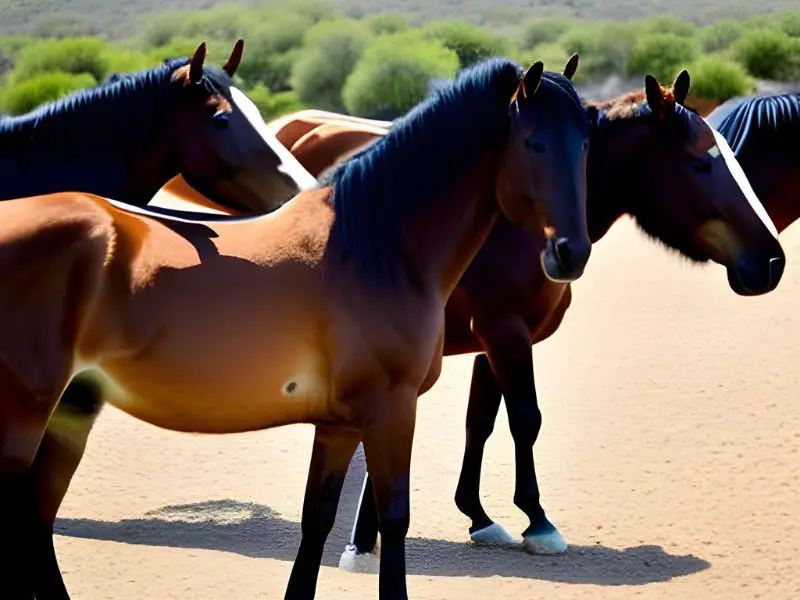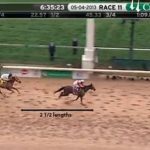Why do horses raise their heads? Horses raise their heads to help them gain better visibility. Horses have a wide field of vision, but they cannot see directly in front of themselves without raising their heads. Additionally, horses may raise their heads to take in more information from the environment around them and assess potential threats.
Raising the head also helps horses orient themselves when navigating unfamiliar terrain or areas with low visibility, such as foggy climates. Additionally, some horse behaviourists theorize that horses raise their heads for comfort purposes and that doing so can help release pressure on the lower neck muscles and spine. By allowing increased blood flow through these areas.
Horses raise their heads for a few different reasons. One reason is that they are trying to get a better view of their surroundings, which allows them to be aware of potential threats or food sources. Horses also naturally lift their heads when excited or experiencing strong emotions such as fear or joy.
Raising the head can help horses better express themselves and communicate with other horses in the herd. Finally, raising the head helps release tension from the neck muscles and offers relief from pain caused by ill-fitting tack, improper riding technique, and poor posture while ridden.
Horse Head Bobbing While Standing
Horsehead bobbing while standing is a common way horses express excitement and contentment. This behaviour often occurs when the horse is in a comfortable, relaxed state and can also be seen during feeding times as an indication of anticipation. It may also be used to indicate curiosity or attention-seeking behaviour.
Horse owners should pay close attention to their horse’s body language when observing this behaviour to ensure it does not indicate any underlying issues such as pain or discomfort.

Why Do Horses Throw Their Heads Up?
Horses are highly intelligent animals that have been domesticated for thousands of years. They possess a variety of behavioural traits, both learned and instinctive.
One behaviour that many horse owners may witness is known as “head tossing” or “head throwing” – when the horse suddenly throws its head up in the air.
There are several potential causes for this seemingly strange behaviour, ranging from medical issues to training mistakes. One common explanation is pain or discomfort caused by ill-fitting tacks, such as a too-tight bridle or saddle, which can cause irritation and lead to head tossing to relieve it.
Other physical explanations include allergies, infections, skin irritations, dental problems, and neurological disorders.
While these can all be diagnosed through veterinary examination, sometimes, they don’t show any outward signs until after the horse has started exhibiting this behaviour.
Another cause could be improper handling during riding sessions; if a rider applies excessive pressure on certain areas of the face while controlling their mount with reins or bits. Then, this can create an uncomfortable sensation, which the horse may express by throwing his head up in response – either out of surprise at sudden contact or frustration at being unable to escape it quickly enough due to harnessing restrictions.
Finally, horses who lack confidence may also demonstrate head tossing to intimidate their rider into backing off from whatever he was asking them to do before feeling overwhelmed.
Ultimately, understanding why your particular animal is doing so will require careful observation and some detective work paired with professional advice where necessary!
Training Methods To Reduce Head Tossing
While head tossing can stem from physical discomfort, it can also become a learned behaviour in response to cues from the handler or rider.
To reduce head tossing that has become habitual, it is important to identify and change the cues that prompt the behaviour. For instance, handlers should ensure tack fits properly and avoid excessive pressure on the reins or bits.
Riders can focus on keeping consistent contact and refraining from abrupt cues. Rewarding periods without head tossing helps reinforce the desired behaviour. Overall, compassionate, clear communication is key.
The Role of Head Position in Horse Communication
Horses rely heavily on body language to communicate within the herd. Subtle ear positions, tail swishes, and head positions convey valuable information. For example, a lowered head with ears back often signals aggression.
A horse observing its surroundings will lift its head high. Mutual grooming sees horses gently resting their heads across each other’s backs. Understanding this equine vocabulary helps handlers interpret their horse’s non-verbal messages.
Noticing small changes in typical head carriage can also alert an attentive handler to potential health issues requiring further evaluation.
Evolutionary Explanations for the Head Bob
The distinctive head bob seen in horses likely originated as an evolutionary adaptation. By bobbing their head, horses gain a wider field of monocular vision, allowing them to detect threats better while grazing.
It may also help them judge distance, facilitating accurate foot placement in rough terrain. The grazing posture with the head lowered likely evolved to aid eating, while the intermittent head raise served a protective purpose.
Over time, this movement pattern became ingrained in horses. Today, domesticated horses exhibit the head bob even in relaxed situations, retaining this vestige of their wild ancestry.
Why Do Horses Lift Their Heads When Walking?
When horses walk, they lift their heads high in a graceful arch. This behaviour is known as the “head carriage” and has aesthetic and practical benefits for the horse.
On a purely visual level, the head carriage can make a horse look more impressive or regal.
It can also be used to display dominance or alertness – some breeds are instinctively bred to carry their heads higher than others!
But on a functional level, lifting its head helps the horse see what’s ahead while walking. By raising its head several inches above ground level, the horse can spot potential hazards sooner and react more quickly if needed.
Additionally, this posture allows the animal to take deeper breaths of air while still maintaining balance – something that’s especially important when navigating rough terrain or carrying riders on its back!
All in all, lifting its head while walking is an essential part of being a healthy and safe horse.
What Does It Mean When a Horse Bobs His Head Up And Down?
When a horse bobs its head up and down, it communicates with you. This gesture can have many meanings depending on the situation, so it’s important to pay attention to your horse’s body language.
Generally speaking, when a horse bobs his head up and down quickly, he may be trying to convey excitement or alertness.
He could also attempt to get closer to you or another animal to show affection or interest. On the other hand, if the bobbing is slow and steady (usually combined with an open mouth), this usually means he is feeling anxious about something.
If your horse continues this behaviour for too long without any response from you, consider taking a step back until they feel more comfortable again.
Ultimately, understanding what your horse is saying through body language, like bobbing their head, can help build trust between you two and make for a better relationship overall!
Fixing A Horse That Tosses Their Head Or Throws Their Head
Conclusion
This article has shown us that horses raise their heads for various reasons, from instinctive to learned behaviours. It is important to observe these natural behaviours and understand how they can benefit our relationship with our horses.
With this knowledge, we can better appreciate all the unique qualities that make up each horse and work to create an even stronger bond between them and ourselves.
Janet G Kulick is an experienced horse rider, trainer, and owner of the informative horse blog, Horseray.com. Her engaging writing style and wealth of knowledge on horse care, riding, and training make her a trusted source for horse enthusiasts worldwide.






